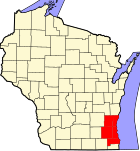WOW counties

| Census | Pop. | Note | %± |
|---|---|---|---|
| 1860 | 66,135 | — | |
| 1870 | 67,757 | 2.5% | |
| 1880 | 67,860 | 0.2% | |
| 1890 | 70,964 | 4.6% | |
| 1900 | 75,181 | 5.9% | |
| 1910 | 78,007 | 3.8% | |
| 1920 | 84,660 | 8.5% | |
| 1930 | 96,303 | 13.8% | |
| 1940 | 110,159 | 14.4% | |
| 1950 | 143,164 | 30.0% | |
| 1960 | 242,809 | 69.6% | |
| 1970 | 349,625 | 44.0% | |
| 1980 | 432,155 | 23.6% | |
| 1990 | 472,874 | 9.4% | |
| 2000 | 560,577 | 18.5% | |
| 2010 | 608,173 | 8.5% | |
| 2020 | 635,242 | 4.5% |
The WOW counties are three counties in the southeast of the U.S. state of Wisconsin: Waukesha, Ozaukee, and Washington. They lie to the west, north, and northwest of Milwaukee, respectively, and are part of the Milwaukee metropolitan area.[1] Collectively, the three counties have a population of 641,131 as of July 2022.[2] Like the collar counties surrounding Chicago, these counties have a primarily white population, and unusually so considering the trend of suburbs around cities in the Rust Belt region becoming more racially diverse.[3] Racine County, to the south of Milwaukee County, has similar demographics outside the city of Racine (though some communities have lower average income), but is usually not included.
Historically, the WOW counties were among the most Republican areas in the state. With the GOP's increasing trend toward right-wing populism under Donald Trump, however, several rural areas of Wisconsin have become significantly more Republican than the WOW counties in most races, including the non-partisan Superintendent of Public Instruction (where pro-school choice and voucher candidates who support traditional pedagogy are preferred). While the WOW counties remain solidly Republican, the party’s landslides have diminished somewhat in the Trump era, shrinking from 2 to 1 in 2012, to 3 to 2 in 2020.
All county offices are held by Republicans; indeed, there are almost no elected
Election history
The Wow counties as a collective have voted for 20 of the 21 most recent Republican presidential campaigns, and in the most recent election that the Democratic Party took the region, Barry Goldwater lost by about 6.5% in an election where he lost Wisconsin by a margin of roughly 24.3%.
| Year | Republican | Democratic |
|---|---|---|
2020
|
60.88% 253,780 | 37.67% 157,029 |
2016
|
60.92% 224,747 | 32.59% 120,246 |
2012
|
67.03% 253,640 | 32.00% 121,104 |
2008
|
62.40% 225,053 | 36.50% 131,637 |
2004
|
67.57% 240,471 | 31.63% 112,574 |
2000
|
65.65% 205,422 | 31.15% 97,464 |
1996[13]
|
55.15% 139,636 | 34.67% 87,777 |
1992[13]
|
50.34% 137,005 | 27.74% 75,488 |
1988[13]
|
61.13% 137,694 | 38.25% 86,166 |
1984[13]
|
66.13% 141,603 | 33.18% 71,044 |
1980[13]
|
58.81% 125,643 | 32.92% 70,335 |
1976[13]
|
58.34% 109,033 | 39.15% 73,180 |
1972[13]
|
60.29% 90,496 | 35.65% 53,510 |
1968[13]
|
55.48% 72,151 | 36.37% 47,297 |
1964[13]
|
46.59% 53,274 | 53.24% 60,876 |
1960[13]
|
57.73% 61,233 | 42.16% 44,714 |
1956[13]
|
69.86% 57,187 | 29.42% 24,082 |
1952[13]
|
67.67% 51,529 | 32.33% 24,437 |
1948[13]
|
55.13% 29,066 | 44.87% 22,606 |
1944[13]
|
60.88% 32,571 | 39.12% 20,457 |
1940[13]
|
57.91% 30,140 | 42.09% 21,204 |
References
- ^ "Workforce observations for Milwaukee County/WOW counties (May 2004)". Wisconsin Digital Archives. May 2004. Archived from the original on 2017-12-04. Retrieved 2017-12-04.
- ^ "State & County QuickFacts". United States Census Bureau. Archived from the original on September 11, 2023. Retrieved February 9, 2021.
- ^ "Base Politics: Why Scott Walker's current troubles were entirely predictable". Slate. 23 February 2015. Archived from the original on 4 December 2017. Retrieved 3 December 2017.
- ^ "2008 Presidential General Election Results – Wisconsin". Archived from the original on 2022-05-21. Retrieved 2022-04-12.
- ^ "The 'WOW' counties suburbs are diverging politically, as some get redder and others grow increasingly purple". Journal Sentinel. Archived from the original on 2023-08-23. Retrieved 2023-08-23.
- ^ "Wisconsin Election Results: Scott Walker Wins Re-election". The New York Times. 2014-12-17. Retrieved 2023-04-13.
- ^ Schneider, Christian. "In the Trump era, Waukesha County remains as crucial as ever for Republicans". Journal Sentinel. Archived from the original on 2023-05-28. Retrieved 2023-04-13.
- ^ "Wisconsin's Swing State Status Hinges on "WOW" Counties". CBS 58. Archived from the original on 2017-12-04. Retrieved 2017-12-03.
- ^ Opoien, Jessie (October 6, 2016). "Wisconsin Senate GOP leader predicts 'WOW' counties will lead Donald Trump to victory". The Capital Times. Archived from the original on 2017-12-04. Retrieved 2017-12-04.
- ^ "How And Where Trump Won Wisconsin in 2016". WisContext. 2016-11-18. Archived from the original on 2017-12-04. Retrieved 2017-12-04.
- ^ "Reporter: Trump Still Struggling With Conservative Vote In State's Most Republican Counties". Wisconsin Public Radio. 2016-10-03. Archived from the original on 2017-12-04. Retrieved 2017-12-04.
- ^ "More Wisconsin Elections Results". Wisconsin Elections Commission. Archived from the original on 2016-10-14. Retrieved 2020-06-24.
- ^ a b c d e f g h i j k l m n o "Dave Leip's Atlas of U.S. Presidential Elections". Archived from the original on 2011-02-22. Retrieved 2022-04-12.

